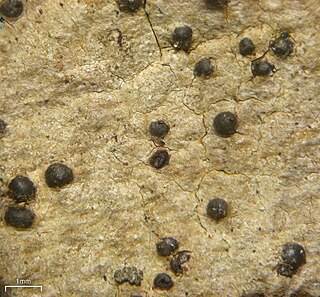
The Pyrenulales are an order of ascomycetous fungi within the class Eurotiomycetes and within the subphylum Pezizomycotina.
Pyrgillus is a genus of lichen-forming fungi in the family Pyrenulaceae. The genus was circumscribed by the Finnish lichenologist William Nylander in 1858.
Mazaediothecium is a genus of calicioid lichens in the family Pyrenulaceae. It has four species. The genus was circumscribed by Dutch lichenologist André Aptroot in 1991, with Mazaediothecium rubiginosum assigned as the type species.

Lithothelium is a genus of lichen-forming fungi in the family Pyrenulaceae. Most of the species are found in tropical climates, and are usually corticolous (bark-dwelling) or saxicolous (rock-dwelling). The genus was circumscribed by Swiss botanist Johannes Müller Argoviensis in 1885.
Clypeopyrenis is a genus of lichen-forming fungi in the family Pyrenulaceae. The genus was circumscribed in 1991 by Dutch lichenologist André Aptroot, with Clypeopyrenis microsperma assigned as the type species. This lichen, originally described from material collected in Costa Rica, is also found in the Caribbean and South America. Clypeopyrenis porinoides was added to the genus in 2011; it was discovered in Costa Rica, close to the type locality of the type species.

Porina is a genus of lichens in the family Trichotheliaceae. A 2020 estimate places about 145 species in the widespread genus.
Septotrapelia is a genus of lichen-forming fungi in the family Pilocarpaceae. It has four species. It was validly published as a genus in 2007 by lichenologists André Aptroot and Jose-Luis Chaves.

Mazosia is a genus of lichen-forming fungi in the family Roccellaceae. The genus was circumscribed by Italian lichenologist Abramo Bartolommeo Massalongo in 1854.

Anisomeridium is a genus of lichens in the family Monoblastiaceae. The type species was originally named Arthopyrenia xylogena by Swiss botanist Johannes Müller Argoviensis in 1883; in 1928, Maurice Choisy defined the genus Anisomeridium, designating A. xylogena the type species.

The Trypetheliaceae are a family of mainly lichen-forming fungi in the order Trypetheliales. The family consists almost exclusively of corticolous (bark-dwelling), crustose lichens with an almost strictly tropical distribution.
Punctonora is a genus of lichen-forming fungi in the family Lecanoraceae. The genus was circumscribed in 1997 by lichenologist André Aptroot, with Punctonora nigropulvinata assigned as the type species. A second species was added to the genus in 2018.
Physma is a genus of cyanolichens in the family Pannariaceae. It has five species. The genus was circumscribed by Italian lichenologist Abramo Bartolommeo Massalongo in 1854, with Physma boryanum assigned as the type species.
Aptrootia is a genus of fungi in the family Trypetheliaceae. It has three species. The genus was circumscribed by Robert Lücking and Harrie Sipman in 2007, with Aptrootia terricola assigned as the type species. This species, originally described by Dutch mycologist André Aptroot as a species of Thelenella, is known from Papua New Guinea and Costa Rica. Later molecular work showed that the species did not belong in Thelenella, but rather, in the Trypetheliaceae, with a sister taxon relationship to a branch including Bathelium and a lineage containing Trypethelium floridanum. The new genus name honours Aptroot, "in recognition of his numerous contributions to tropical lichenology".

Architrypethelium is a genus of lichen-forming fungi in the family Trypetheliaceae.
Pseudopyrenula is a genus of lichen-forming fungi in the family Trypetheliaceae.
Tania is a genus of lichenized fungi in the family Roccellaceae. It has two species. The genus was circumscribed by Maria Egea Fernández, Pilar Torrente and Harrie Sipman in 1995, with Tania lanosa assigned as the type, and at that time, only species. A second species, T. mohamedii, was added to the genus in 2006. The genus name honours bryologist Benito Ching Tan (1946–2016), who organized the expedition to Mount Kinabalu and collected the type species with Sipman.
André Aptroot is a Dutch mycologist and lichenologist.

Coenogonium is a genus of filamentous lichens in the monotypic family Coenogoniaceae. It has about 90 species. Most species are leaf-dwelling or grow on bark, although a few are known to grow on rocks under certain conditions, and some are restricted to growth on termite nests. The genus was circumscribed in 1820 by German naturalist Christian Gottfried Ehrenberg.
Megalotremis is a genus of lichen-forming fungi in the family Monoblastiaceae. It has 16 species. The genus was circumscribed by Dutch lichenologist André Aptroot in 1991, with Megalotremis verrucosa assigned as the type species. Megalotremis is a pyrenolichen genus, meaning its species have perithecioid ascocarps: spherical or flask-shaped, sessile or partly immersed in the thallus, with a single opening (ostiole) and enclosed by a distinct wall.







